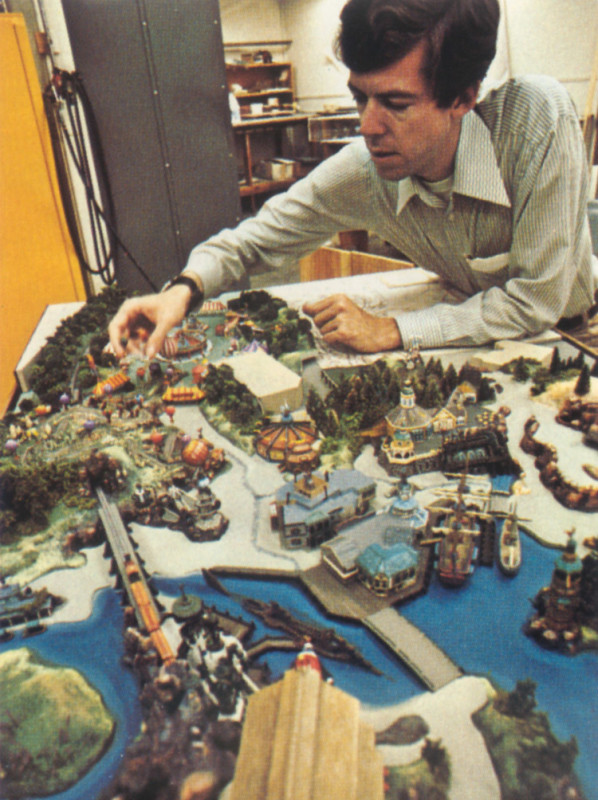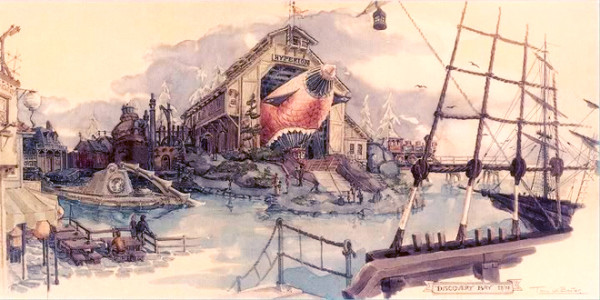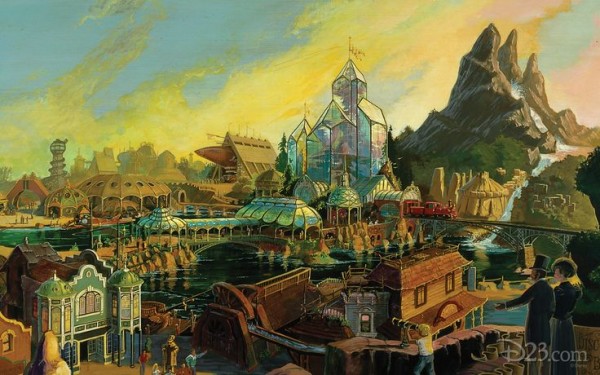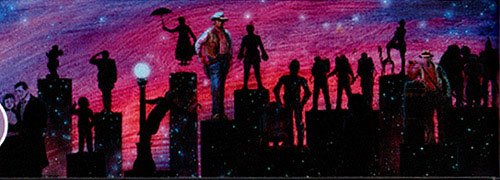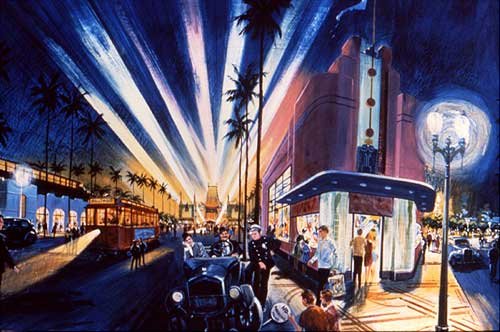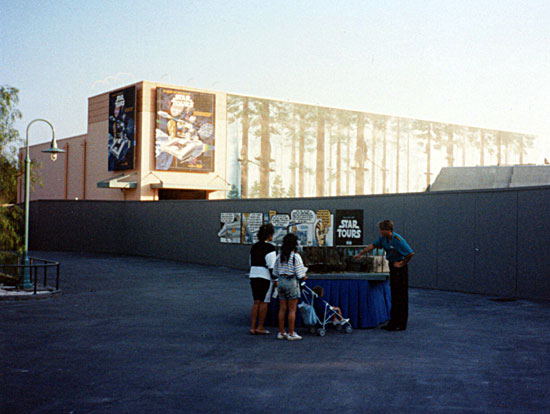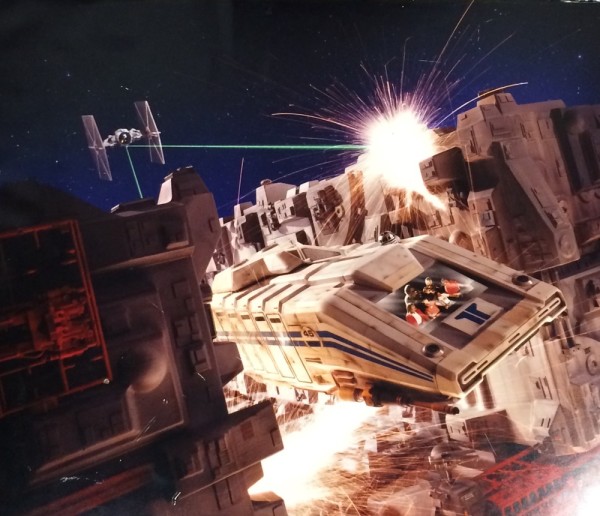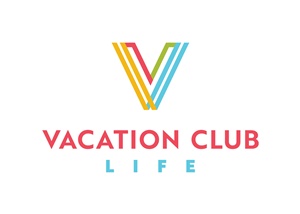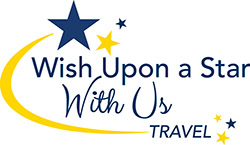But, being honest with myself, that is not the only thing that has really stopped me from writing. You see, I know what the next target on my Imagineering plan to remake Epcot (Plan Alpha) is, and I’ll admit something here, don’t tell anyone: I never formed a real emotional bond with Wonders of Life.
Archive for WDW Daily News
Was Wonders of Life Wonderful? by Scott Shindeldecker
THE ORIGINAL PLEASURE ISLAND BY SAM ALLEN
The area of Walt Disney World now known as Disney Springs has gone through a lot of changes over the year. “The Landing,” in particular, has seen a lot of new developments debut over the last year including “The Boathouse,” “Jock Lindsey’s Hangar Bar”, and “Morimoto Asia,” to name a few. In fact, not too long ago, this district went by a different name inspired by an infamous location from Walt Disney feature-length adaptation of “Pinocchio”: Pleasure Island.
‘D’s Throwback Disney: One Little Spark Part One’ by David Caamano
About a decade before Epcot Center opened, a young college boy began his Disney career working part time as an ice cream scooper at Disneyland. This young man is also known as Tony Baxter. He would be the Marc Davis in a new generation of Imagineers after Walt’s death. He played a key role in attractions such as Splash Mountain, Big Thunder Mountain, Star Tours and Journey into Imagination. The central attraction at the Imagination pavilion at Epcot first opened 33 years ago. The original Journey into Imagination featuring Figment and the Dreamfinder would have celebrated this birthday last Saturday, the 5th if March. That is if it had remained in its original form. But before I begin the journey into the original imagination attraction at Epcot, we should visit a brilliant, yet unrealized land expansion, known as Discovery Bay.
Shortly after completing college at Cal State in 1969, Baxter was hired by Disney in the Imagineering department. He was immediately sent to Florida, under the supervision of Davis, to help with the 20,000 Leagues Under the Sea attraction at the Magic Kingdom. Shortly after that, he found himself at the helm of a Disneyland revitalization project. He was tasked the challenge to create a new land on the shores of the Rivers of America. Discovery Bay was to be a balance between fantasy and technology set against the backdrop of 1860s San Francisco. It was to be a steampunk style land before the term was coined and was announced to be coming to the park around 1976. One of the attractions that Baxter had in mind was to be called Mr. Marvel’s Gallery of Wonders. The show’s concept was very similar to the Carousel of Progress in that guests would sit in a rotating theatre around a stationary stage which included various scenes with animatronics. Since the Carousel of Progress show proved to be very popular and recently moved to Florida, it made sense that Disneyland needed a similar style show in its replacement. Mr Marvel was to be a professor of imagination and the show would be the professor showcasing his collection of inventions and unique animals. One of those animals was originally going to be a friendly green dragon. (It actually sounds very similar to the basic story and characters of Mystic Manor at Hong Kong Disneyland.)
Unfortunately, Discovery Bay was a victim of the chopping block. One of the big reasons it was cancelled was due to the box office failure Island at the Top of the World. This new land’s E-ticket attraction was to be a ride based on this film. A combination of this failure and the public’s interest in the mid 1970s shifting to adventure stories and films set in space (i.e. Star Wars) led Imagineers to stopping the project. Also by the mid 70s, Imagineering had to refocus its staff towards two new park developments; Epcot in Florida and Tokyo Disneyland. Both of these enormous projects were slated to open in the early 1980s.
Even though Tony Baxter’s dream of Discovery Bay failed to become a reality, he still was able to breathe new life into that area of Disneyland by 1979. His family thrill ride, Big Thunder Mountain, was a hit and marked the beginning of a new era of attractions from Disney. Many of the ideas of this land saw the light of day in some form or another both at Disneyland Paris and Tokyo Disney Sea. But Epcot would become the home of a new imagination attraction that included his original character duo. He even brought elements of his adapted version of Carousel of Progress to the Imagination’s ride system.
Stay tuned tomorrow as we discover how Baxter’s little spark of imagination developed one of Epcot’s most beloved characters and attraction.
THE WILD INSPIRATIONS BEHIND ZOOTOPIA BY SAM ALLEN
In addition to celebrating the natural world, Disney’s Animal Kingdom also celebrates those animals that live in our imaginations including those brought to life through Disney animation. Recently a new exhibit opened up in the park’s “Rafiki’s Planet Watch” area all about Walt Disney Animation Studios’ latest feature film: “Zootopia.”
MONSTERS INC. OPEN HOUSE BY SAM ALLEN
Throughout time, children across the world have been afraid of the monsters that lurk in the shadows of their closets and beneath their beds. However, Pixar’s 2001 release “Monsters Inc.” flipped this idea on its head by showing that monsters are as scared of kids as kids are of monsters. In the film, the city of Monstropolis is powered by the screams of human children, whom its citizens believe to be lethally toxic to any monster who comes into direct contact with them.
‘D’s Throwback Disney: The Great Movie Ride’ by David Caamano
After the initial success of Epcot Center in 1982, Imagineers returned to work to complete more attractions that didn’t premiere on the park’s opening day, especially in Future World. When the front half of the new park opened in 1982, there were only four completed pavilions with all their attractions and Spaceship Earth. Horizons, where Mission: Space stands today, was still under construction on the park’s opening day. The Imagination pavilion only had Magic Journeys, the Figment attraction was still not complete, The Living Seas was still in the concept stage, and the Wonders of Life pavilion wasn’t even a thought yet. Needless to stay, even though Epcot was a hit, it needed more attractions in Future World to entertain guests.
Now you’re probably wondering what all these attractions in Future World have in common with The Great Movie Ride. There is, in fact, a relatively unknown connection between the two. While Imagineers were still fleshing out the Future World pavilions, under the management of Marty Sklar, a movie making themed attraction was also in the works for Epcot.
Sandwiched in between the Imagination pavilion and Land pavilion, ride designers positioned the idea of ‘Great Moments at the Movies’ attraction. It was to be an educational experience revealing the process of making movies. The entrance of the pavilion would have been a big departure from the style of the other show buildings in Future World. Most of the buildings in Epcot took a queue off of Walt’s designs for his pavilions at the 1964/1965 New York World’s Fair. These buildings were sleek in their mid-century modern design. The Epcot pavilions were not quite as stylish, but reflected design aesthetics of the late 70s and early 80s. The Epcot pavilions were grand in size and scope. They housed huge track rides (mostly omnimover type rides) that could handle large capacities at any given time, and this movie-making ride would be the same. The entrance to ‘Great Moments at the Movies’ was to be very different from the rest of Future World, but would be just as magical. There was to be a large flat structure that would have hung a mural of nothing but a blue sky. At the very center of that mural was a very small box office entrance to a cinema with a marquee. The simplicity of this entrance, especially now knowing the size and detail of what this attraction would have in store once inside, presented a sense of wonder and magic.
There is very little detail of what else Imagineers had planned for this Future World pavilion of making movies. But planning for this version of the attraction came to a stop once Disney’s new CEO came into office, Michael Eisner. Eisner and Sklar discussed the plans for this attraction, and naturally Eisner coming from the movie making business himself was certainly intrigued. But I suppose some obvious facts came into play. First of all, as much as a movie-based attraction aimed to educate guests on the technical and scientific side made sense at Epcot. However, the overall established layout of Future World didn’t have an appropriate location for the pavilion. The landscaping and aesthetics of Future World East are meant to reflect the attractions which are focused on ‘hard sciences’; science that coincides with mathematics and design. The footpaths are straight, or consists of right angles mostly. Future World West focuses on the ‘soft sciences’; that is science that focuses on natural elements, like the land, sea and human imagination. Again, the footpaths planters on this side have a curved shaped.
D’s Throwback Disney: The Original Star Tours Adventure – Part 2 by David Caamano
Last time I talked about some interesting details about the birth of the original Star Tours attraction in California. Today we will embark on a journey on how Star Tours came to Florida at the Disney MGM Studios. But first, a little side trip about what Imagineers originally were thinking for a thrill ride based on the famous space saga.
Originally, even before George Lucas came into the picture, Imagineers were quietly brainstorming on thrill ride ideas based in the Star Wars universe. When Lucas was finally approached by Disney to co-develop a Star Wars attraction, Imagineers pitched their original idea to the film director. Originally designers had an idea for hybrid rollercoaster attraction. It is very possible that in California this would’ve replaced the fan-fan-favorite Space Mountain. The attraction’s main feature, aside from hair-raising thrills, was that the ride’s ending would be customizable. Guests would get to either choose, or be given a random selection of a destination in the Star Wars universe. This would provide guests with a different experience every time. However, this type of technology was no where near possible in the mid 1980s. Lucas would eventually help Disney develop a tracked simulator attraction with Indiana Jones, but that’s another story.
With the capabilities of developing the Imagineers’ ultimate Star Wars dream lightyears away, Eisner sent the team back to the drawing board. The Disney company was in a bad place when Eisner was hired as CEO. The company had nearly been sold off into pieces, so it was up to Eisner to rejuvenate the company, and fast. Eisner, along with Lucas and Imagineers, came to the conclusion that they needed a Star Wars attraction that could be built with cutting-edge technology, but readily available. Eisner knew that Lucas’ story and characters would draw crowds in. But what type of ride would they build?
Disney had first developed plans for a simulator attraction based on the little known sci-fi film, The Black Hole. The film was produced by Walt Disney Pictures in 1979, just a few years after the first Star Wars film. Once again, designers were tinkering with the idea that guests would get to choose their destination on the ride. But since the budgeted cost was astronomical at a point when the company wasn’t financially flush, and the film was a box-office bomb, Imagineers shelved the idea. Elsewhere in 1977, while film fans were lining up to watch Lucas’ hit film, Joseph Strick, another filmmaker, began expanding is own ideas of multi sensory entertainment system. He invented the six-axis motion simulator. Once he was confident with his system, he approached Disney about using this ride model for an attraction. So by the time Eisner was looking for a new piece of technology for Lucas’ thrill ride, Disney revisited Stick’s new invention which was specifically geared to be used for entertainment, and began adapted a ride simulator attraction for Star Wars. Disney purchased four military-grade flight simulators, each costing $500,000.
MICKEY MOUSE HEADLINES SHORT FILM FESTIVAL AT EPCOT BY SAM ALLEN
During the early days if the Disney Studios, Walt used the short films he produced as a way to experiment with the possibilities of what animation could do. Some of the technological advancements made during this time, including the introduction of synchronized sound and three-strip Technicolor, helped set Disney’s output apart from his competitors and led the way to more ambitious feature-length projects.
D’s Throwback Disney: The Original Star Tours Adventure – Part 1 by David Caamano
George Lucas’ beloved characters from the epic space saga first flew onto Disney property on January 9th, 1987 at Disneyland in California. The first simulator ride of it’s kind in a theme park replaced the omnimover ride, Adventures thru Inner Space. The new thrill ride had a final cost of $32 million. It was double the amount it cost Walt to build all of Disneyland in 1955. Needless to say, the collaboration between George Lucas and Disney paid off and the attraction became a smash hit. But it seems that Lucas always intended the ride to be upgraded. To change from time to time, traveling to new exciting worlds. Yet the attraction never saw an upgrade until nearly 25 years later. Let’s look back on a history and the relationship between the film director and the mouse himself with the popular attraction known as Star Tours.
Captain EO was the first attraction to open at a Disney park with George Lucas’ name attached. The 3D film was a new story story about a space captain, played by Michael Jackson, and his ragtag space crew delivering a gift of song and dance to an evil supreme leader. The movie experience opened at Epcot on September 12th, 1986 and at Disneyland, right below Space Mountain, just six days after. To the public, this was the first Lucas/Disney collaboration. But Lucas began working on the original Star Tours attraction a few years prior to Captain EO’s premiere. At a press conference in 1987, Lucas said that he always wanted to work on an attraction with Disney, and he believed his talents and imagination would naturally fit for an attraction in Tomorrowland. He referred to Disney as the ‘Rolls-Royce’ of amusement parks and he was only willing to allow a company of that status to even come close to his characters from Star Wars. This opening day press conference at Disneyland is fascinating from today’s perspective. Lucas made three clear points throughout the press event. First, that the attraction would make no sense if it was in 3D. Secondly, that the attraction was intended to be upgraded from time to time. Finally, he expressed his confidence that his Star Wars attraction was the best Disney had ever developed. In fact, he half-way arrogantly boosts that Star Tours was far superior to attractions such as Space Mountain.
His comment about the attraction not suited for 3D came out of a question related to Captain EO. The public loved that the visionary director helped developed Disney’s 3D based attraction. It was natural for them to think that Lucas and Imagineers would continue down that path of using 3D with an attraction such as Star Tours. After all, this is a ride based on a film that pushed the boundaries of visual effects. But Lucas very clearly stated that 3D wouldn’t make sense, because guests were watching a film that was an image of what they were meant to be seeing out of a window. If something popped out in 3D and into the interior space of the starspeeder, this would imply that an object broke through the glass. We all know what would happen if a glass window on a spaceship breaks while traveling in outer space. We would die instantly. Imagineer Marty Sklar, also mentioned how a park guests claimed to have lost her glasses while riding in the back row because of the ride’s intensity. Another reason why wearing 3D glasses on the simulator wouldn’t work…back then at least. Lucas, and the rest of the panel, quickly brushed the silly question aside as if it was insignificant.
Finally, festival space at Epcot by Scott Shindeldecker
The time has come to finish up this pavilion imagineering so that I can move along to talk about some other things.
I know you are all screaming “Nooooo, we’ve loved the 10,000 words devoted to something that will never happen! Can we get 10,000 more?”
I’m pretty sure I can find a way to do that again in the future, but for now, it’s time to address the thing that started this pavilion out in the first place: festival space.


